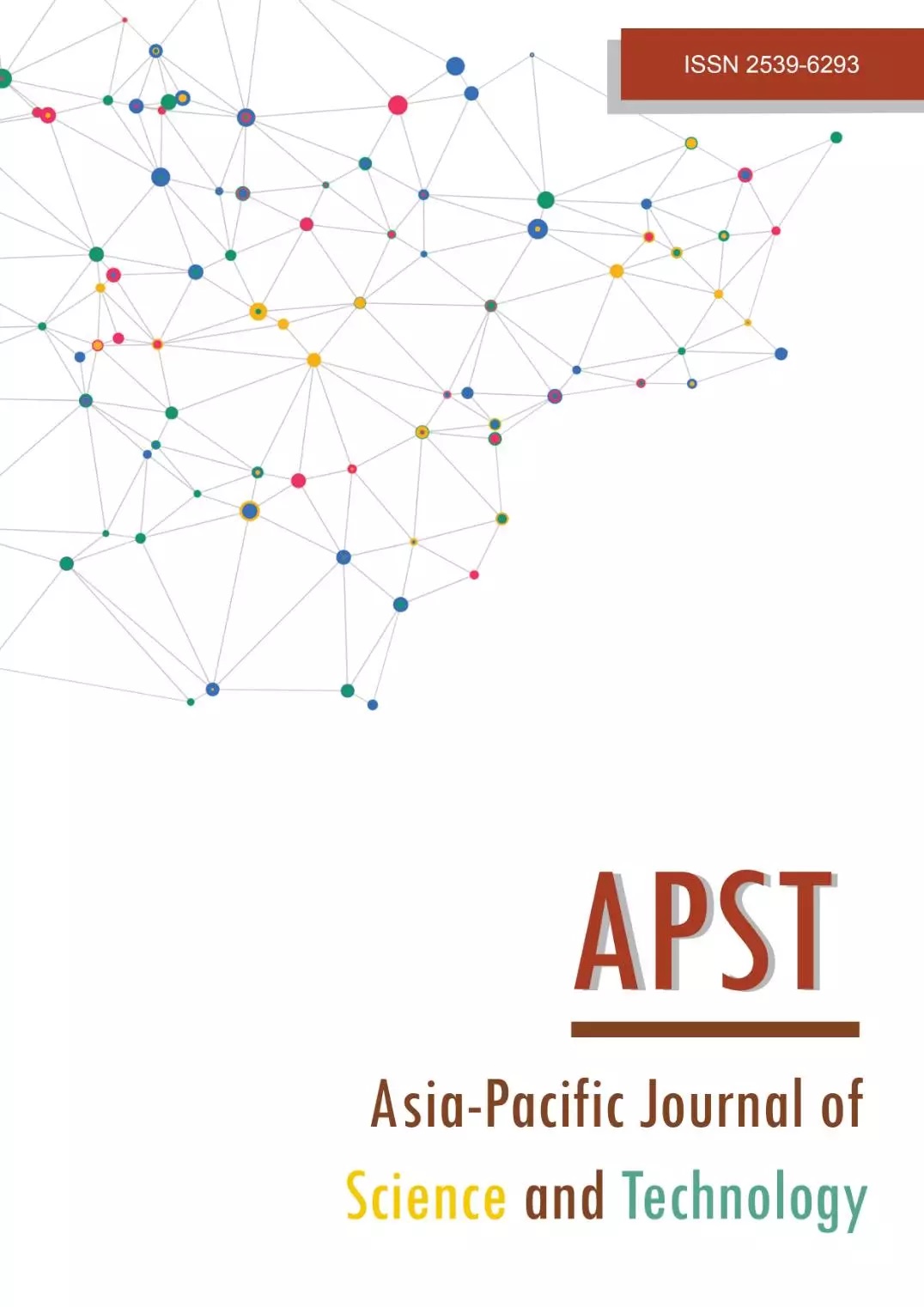Effect of human massage and machine stirring processes on dehydration correlating physical texture of white radish
Main Article Content
Abstract
The present work examines the effect of salting on the drying characteristics and quality of white radish for preservation; the findings can be useful in replacing human labor for a community enterprise of Banka district, Ratchaburi Province, Thailand. The preservation of fresh white radish using salting and sun drying can extend storage duration and add value to the product. The traditional process consists of hand massage for 1 h/day, sun drying for 6 h/day, and keeping it in plastic sack for overnight (17 h/day) to remove moisture until the weight of the product is less than 40% of the initial weight. The machine stirrer decreased moisture content in radishes faster than that of traditional human force because water inside radish moves out quickly with the osmotic pressure gradient to establish equilibrium with salt solution. With the increased rotating speed of the machine increases, the hardness of radishes gradually decreases. The optimum conditions for stirring machine were observed at 50 rpm for 1 h/day to keep their hardness over 80 newtons. The properties of salted radish from stirring machine are as follows: 11.8 wt% of salinity, 0.80-0.85 of water activity, 63 to 65 of brightness value, and 80-85 newtons of texture hardness; these properties are similar to processing radish with hand massage method. Based on the findings, this research recommends investing in a solar dryer along with machine stirrer to reduce more moisture content, prevent dust contamination, decrease the number of stirring sessions; thus, reducing drying time.
Article Details

This work is licensed under a Creative Commons Attribution-NonCommercial-NoDerivatives 4.0 International License.
References
Gençcelep H. The effect of using dried mushroom (Agaricus bisporus) on lipid oxidation and color properties of sucuk. J Food Biochem. 2012;36(5):587-594.
Agricultural and Cooperative Development Plan of Ratchaburi Province, Thailand (2018 - 2022): review edition Ratchaburi Provincial Agriculture and Cooperatives Office, Ministry of Agriculture and Cooperatives. [cited 2023 May 1] Available from https://www.opsmoac.go.th/ratchaburi-strategic-files-411691791792.
Deng VL, Mujumdar AS, Zhang Q, Yang X, Wang J, Zheng Z, et al. Chemical and physical pretreatments of fruits and vegetables: Effects on drying characteristics and quality attributes - a comprehensive review. Crit Rev Food Sci Nutr. 2019; 59(9):21-46.
Ndawula J, Kabasa JD, Byaruhanga YB. Alterations in fruit and vegetable beta-carotene and vitamin C content caused by open-sun drying, visqueen-covered and polyethylene covered solar-dryers. Afr Health Sci. 2004;4(2):125-130.
Timoumi S, Mihoubi D, Zagrouba FS. Vitamin C degradation and aroma losses during infra-red drying of apple slices. LWT-Food Sci Technol. 2007;40(9):1648-1654.
Nowacka M, Wiktor A, Śledź M, Jurek N, Witrowa-Rajchert D. Drying of ultrasound pretreated apple and its selected physical properties. J Food Eng. 2012;113(3):427-433.
Nadeen OC, Faye HC, Clark TH, Gerard AA. Direct measurement of osmotic pressure of glycosaminoglycan solutions by membrane osmometry at room temperature. Biophys J. 2005;89:1543-1550.
Akbarian M, Ghasemkhani N, Moayedi F. Osmotic dehydration of fruits in food industrial: a review. Int J Biol Sci. 2013;3(12):1-16.
Coogan RC, Ron W. Flavour changes in Asian white radish (Raphanus sativus) produced by different methods of drying and salting. Int J Food Prop. 2008;11(2):253-257.
Amer BA, Morcos MA, Sabah MA. New method for the mathematical determination of drying rates of fig fruits depending on empirical data under conditions suiting solar drying. In: Wollny C, Deininger A, Bhandari N, Maass B, Manig W, Muuss U, et al, editors. Deutscher Tropentag 2003: Technological and Institutional Innovations for Sustainable Rural Development; 2003 Oct 8-10; Lower Saxony, Germany. Lower Saxony: klartextGmbH; 2003. p.1-13.
Javed A, Ahmad A, Nouman M, Hameed A, Tahir A, Shabbir U. Turnip (Brassica rapus L.): a natural health tonic. Braz J Food Technol. 2019;22:1-9.
Wells JD. Salt activity and osmotic pressure in connective tissue. A study of solutions of dextran sulphate as a model system proceeding of the royal society of London. Series B Biolo Scie. 1973;183(1073):399‒419.
Singh B, Suri K, Shevkani K, Kaur A, Kaur A, Singh N. Enzymatic browning of fruit and vegetables: a review. In: Kuddus M, editor. Enzymes in food technology. 1st ed. 2018; Springer Nature Singapore Pte Ltd. p. 63-78.
Moreno C, Cuvi AM, Zaro MJ, Darre M, Vicente AR, Concellón A. Short UV-C treatment prevents browning and extends the shelf-life of fresh-cut carambola. J Food Qual. 2017;2548791:1-9.
Li H, Zhao C, Guo Y, An K, Ding S, Wang Z. Mass transfer evaluation of ultrasonic osmotic dehydration of cherry tomatoes in sucrose and salt solutions. Int J Food Sci. 2012;47(5):954-960.
Pavkov I, Radoǰcin M, Stamenkovі́c Z, Kešelj K, Tylewicz U, Sipos P, et al. Effects of osmotic dehydration on the hot air drying of apricot halves: drying kinetics, mass transfer, and shrinkage. Processes. 2021;9(2):202.
Tapia MS, Alzamora SM, Chirife J. Effects of water activity (aw) on microbial stability, as a hurdle in food preservation. In: Barbosa-Cánovas GV, Fontana AJ, Schmidt SJ, Labuza TP, editor. Water activity in foods: fundamentals and applications. 2nd ed. New Jersey: John Wiley & Sons, Inc.; 2020. p. 239-271
Beuchat LR. Water activity and microbial stability. Fundamentals of water activity, IFT continuing education committee; 2002 Jun 14-15, California, United States. New Jersey: Wiley-Blackwell; 2002.
Samuel AM, Fito PMA. 2000. Water in Foods: A Strategic Entry Report (1965), the University of Michigan, AVI Publishing Company, USA, p.284. [cited 2023 May 1] Available from http://lib3.dss.go.th/fulltext/scan_ebook/j.food_sci_1972_v37_n3.pdf.
Lone K, Charlotte UC, Leif HS, Jens R. Water activity-temperature state diagrams of freeze-dried Lactobacillus acidophilus (La-5): influence of physical state on bacterial survival during storage. Biotechnol Prog. 2009;25(1):265-270.


